Let’s get one thing out of the way right now:
The version of Darksiders II that I am reviewing is the PC version, and it is almost exactly the same as the one I previewed two weeks ago at THQ’s offices at the community preview event for the game. I made a bold claim in that preview, namely the “triumphant return of PC gaming” part. I said it because I believed it. I said it because the game that I spent almost 15 hours playing, on a PC, was fantastic, and because I was told by Vigil and THQ representatives that the minor issues I experienced would be fixed by the time the retail release was out.
There is a tide of PC gamer rage out there on the interwebs tonight, and it’s getting a bit tiring. There are massive discussion threads on NeoGAF, Steam Forums, and the Darksiders II Community Forums, among others, that range from “Thank you Vigil for the fantastic sequel, this is my Game of the Year!” to “Fuck Vigil, they are liars and I am never getting another THQ game as long as I live.” The usual internet gamut. You know how it goes.
My official stance on this, copied from a post I made on the Darksiders II forum, is this:
I reported what I was told and what I experienced during the media preview, and I updated it with my current experiences.
I’ve said it there, and I’ll say it here, and let’s be clear:
Darksiders II is a fantastic game.
Is it the PC version I was told would be available at release? Not quite. Does it look better than a console version? Yes, absolutely. At 1080p, this game looks better on PC than it does on a console, plain and simple. Does it need some tweaks? Yes. There are texture issues (though they are minor). Are they disappointing? Yes. I was hoping those bugs that I saw in the beta version would be fixed. I have no doubt that they will be, via a patch.
The lack of a config file is disappointing but ultimately minor. The game at stock settings looks really good. Let’s not get too neckbeardy here. This PC rage is the kind of stuff that makes PC gamers in general look like entitled twats, and devs (from any publisher) hate that shit. These guys busted their asses to make a phenomenal game and all over the web the console players are basically saying “Wow! This is fantastic! Thanks, Vigil!” while a few PC blowhards are going off about how “shite” THQ and Vigil are and how they’re getting “fucked over”. Come on. The game runs really well. You’re not getting fucked over.
That sums up how I feel. The story is convoluted, with THQ going on record tonight during a live chat saying that there will not be a config file to tweak PC graphic options.
That’s off my chest, now let’s review the game.
Update: 09/07/2012
Vigil will soon be releasing the third major patch for the PC version, and it promises to fix most of the issues that were bothering PC gamers so much. Here are the patch notes.
Death Lives
In Darksiders II you take up the mantle of Death, one of the four Horsemen of the Apocalypse. There’s a bit of lore to the world of Darksiders, told via the first game as well as comics and a novel. The world of Darksiders tells a tale of an eternal battle between Heaven and Hell, presided over by a group called the Charred Council, with arbitration (ahem) provided in a not-subtle manner by the Nephilim (our friends, the Horsemen). In the first game, a great injustice was committed, and the people of Earth suffered greatly at the hands of War.
Death doesn’t buy it, however, and sets off on a mission to clear his brother’s name and undo the atrocities that humanity endured.
The game is ambitious in scope and scale. Expect, at the bare minimum, a first-time playthrough of 30 hours. More realistically, if you veer off to find certain items and complete side quests, you’ll probably clock in closer to 40 or even 50 for completionists like me. If, however, you prefer to plow story and just revel in the sheer joy of the fluid combat the game provides, you will still find a fulfilling game that is worth the money you spent.
One might think that the game is an action combat adventure, and one would be short selling Darksiders II. What they haven’t marketed the game as, but what it actually is, is a large open-world, quest-hub-based RPG with a solid fighting game tacked on.
There is a major quest hub that serves as a central base for Death’s adventures. From this quest hub, you progress the story, shop for gear, sell stuff, train, access the Crucible, and trade items using the mail system.
Death Fights
Combat is where the game truly shines. The combat system was designed by Ben Cureton, who was a figure in the Street Fighter community and has drawn his inspiration from some of his favorite games, including Devil May Cry and Bayonetta. The pedigree shows in Death’s shreddingly fast combos and dodges that, despite their impressive screen display, are actually not that difficult to master—and this is coming from a guy who could never get past button-mashing in Mortal Kombat or Street Fighter games. The beauty of the combat system lies in its simplicity: there are five basic things Death can do in a combat situation in the beginning of the game. He can use his primary weapon (Scythes), his secondary weapon (a heavy or light weapon depending on your choice of build), he can dodge, he can jump kick, and he can shoot. The majority of combat consists of a timed mix of primary and secondary attacks, through which combos are developed. Different button combinations will yield different combo chains, and there is a combo counter (which serves no functional purpose other than bragging rights) to keep track of your performance.
You can probably get through most combat situations with clever use of your scythes and the dodge button, if you were so inclined, but then where would the fun be in that?
Mastering the combos and dodges is supremely satisfying, and lends to a very visceral and fast-paced experience that—at times—ends up making you forget this is anything other than a bad-ass fighting game. The best part is that you feel accomplished as hell when you pull off a rad 40x combo, and you don’t need to train for three years to do it.
Adam Greene over at Marooners’ Rock has an in-depth look at the combat. It’s a good read.
Death Explores
The world of Darksiders II is gorgeous. It has some of the best environmental design I’ve ever seen in a game that isn’t an MMO that rhymes with Morld of Poordraft. Every area has a totally distinct look and feel, and the art direction skillfully applies color palette changes that are consistent with the theme and tenor of the zone you’re in. In an icy world, the game is all blues and whites, with vague swirls of black and purple as the ominous sky darkens and enemies break out of icy tombs to attack you. In the ancient Drenchfort, vines in every shade of green clamber over grey stone mottled with the purples of age while golden leaves hinting at autumn swirl out of the bright blue sky. The art direction is such that each zone has an immediately and distinctly identifiable “brand” of color theme. It’s exceptionally well done, and looks tremendous on a big display in 1080p.
Death is more than just a weapon-swinging killing machine. He’s an extremely agile acrobat, and jumps around the world like a flea (in stark contrast to his heavy-handed brother War). He clambers and scampers over walls and obstacles with nary a second thought. The traversal part of the game is just as satisfying as the combat; it’s well-designed, well-thought-out, and victory is sweet once you figure out how to get to that thing that you can see out of reach.
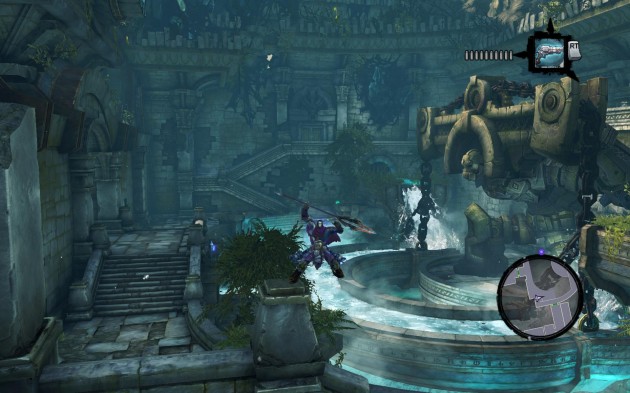
It’s not quite as open-feeling as, say, an Elder Scrolls title or Assassin’s Creed title… the objects that Death can traverse are clearly branded and marked. You quickly learn that to solve many of the traversal puzzles, you just have to look for the telltale wooden beams sticking out of the wall. Liberal use of the camera solves most puzzles.
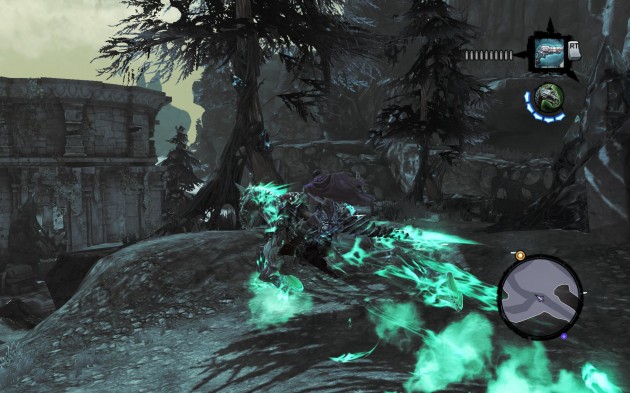
Death rides a pale horse
While Death is in wide-open areas, he can instantly summon his mighty steed (hey, he ain’t called a Horseman for nothing…) Despair. Despair appears almost instantaneously underneath Death when summoned, and goes away just as quickly, with an unholy whinny. From horseback, you can mow down hapless enemies with your scythe (though they can and will knock you off if given the chance). My only wish is that Despair moved a little faster, because some of the wide-open areas in the game are very wide open.
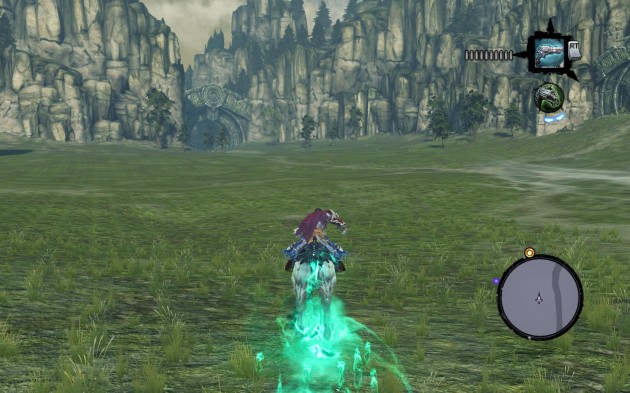
It's a big place
But hey, that’s what fast travel is for. Once you’ve been to a place, you can instantly travel back to it. The devs wanted you to focus on having fun, not walking back and forth between the same areas over and over again.
Another consideration they made is that Death cannot die from environmental damage. This makes sense in that Death should not be able to die from falling off a mountain or falling into lava… He should only be able to die in combat. If you derp Death off a cliff or into a pool of magma, he’ll turn into his reaper form and fly back to a safe spot. This makes the game flow well and gets rid of annoying and useless “Oh I died accidentally and now I have to go back ten minutes” situations.
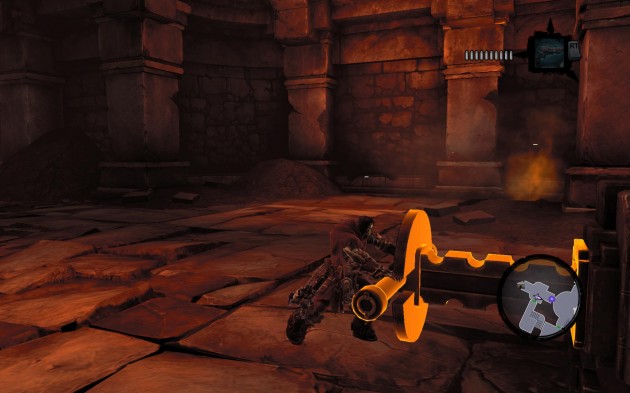
Death pushes things around like he just don't care
Oh, and Death can swim. Fast.
Death sounds great
The soundtrack of the game is really good. Ambient, moody, and sweeping orchestral tracks punctuate the scenery and bring depth to the world. The voice acting is, if not entirely A-list, close enough. Death’s script is a bit hokey, and some of the lines are juvenile and slightly out of character for such a big persona as Death Incarnate, but at least they don’t delve too deeply into the “comic relief” shtick that could ruin parts of an epic game like this.
Death grows
Death starts off as a wee baby Nephilim of level 1. He only knows a few attacks and has barebones equipment. He can level up to 30, however (and it was hinted that DLC will raise this level limit), and he becomes an incredible bad-ass starting at level 12 or so. Not only can you level Death, giving him higher stats, you can also customize your build along two major talent trees (basically strength or summoning, but named Harbinger and Necromancer) and learn new combos and fighting techniques as well. On top of that, you can also level your weapons, if you are lucky enough to find a Possessed Weapon in a chest or as a random drop. The Possessed quality allows you to sacrifice other lesser gear to your ever-hungry Possessed weapon. You can sacrifice specific gear to grant or level up a stat of your choice to suit your fighting style. If you want to get health back on hit, look for weapons with that stat and feed them to your Possessed. If you prefer to focus on arcane damage from your spells, find and sacrifice Arcane Crit and Arcane gear to your Possessed weapon. It adds even more customization to an already satisfyingly customizable experience.
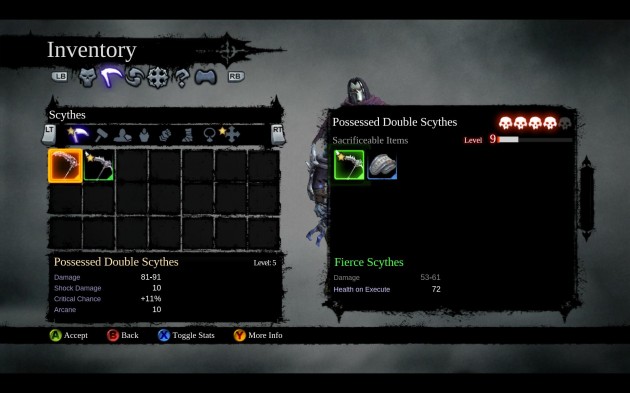
Feed your possessed weapons
If you focus on the arcane tree, you get to learn to summon ghouls and crows to help fight with you. If you focus on the combat tree, you gain even more and varied combat abilities, some of which heal you during combat. Either tree offers a high-level experience of becoming a complete and utter badass.
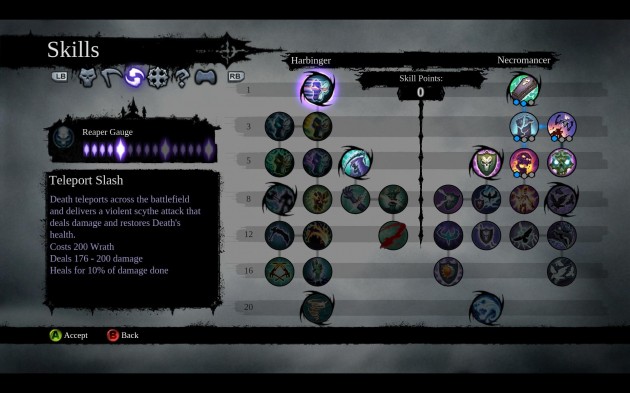
(Necromancer. Ghouls OP, trust me)
If you beat the game, it’s not over. You can start a New Game+ that allows you to keep your character. There’s also the Crucible mode, which is a combat lover’s dream, as it allows you to fight wave after wave of increasingly difficult enemies. In Crucible mode, you can go five rounds and then choose a reward. If you refuse the reward, you can keep fighting for a potentially better one, but if you die, you get nothing (remember Super Paper Mario? Yeah, it’s that). There are 100 waves in Crucible mode.
Death isn’t always pretty
The UI in the game is pretty terrible. The textures are actually straight-out ugly, and the icons for some of the weapons are extremely low-resolution while others are normal resolution. Death’s model in the menu screens looks like a pixelated jumble. Of course we won’t get any straight answers out of THQ or Vigil, but a fellow named Xander Davis might have something to say about that, as he claims on his Twitter feed that he was part of the UI team and nearly his whole team was fired in March. I can believe that the UI hasn’t been touched since March; the only game-crashing bug I experienced during my preview was in the menu system, and the UI feels unpolished and clunky (especially for PC users). There are even major “duh” flaws, like the map screen saying “Press A for overworld map” when it’s actually LS on a controller. There’s no excuse for that amateur-hour level of QC, especially in a AAA title from a major studio.
The UI being amateurish isn’t really a major dealbreaker, though it is annoying. What’s also annoying is the unpolished user experience of things like switching between controller and keyboard requiring restart, changing video resolution requiring a restart, and not being able to save the same playthrough in more than one save slot. When the rest of the game is so polished and awesome, things like this stick out even more because the bar is set higher and we expect better.
Controlling the game with a keyboard and mouse is possible but not elegant, mostly because of the variety and timing required from the combat controls. The keymapping is so non-intuitive that Sledgehammer had to write a guide on how to do it. Further experimentation with non-standard keybindings, thanks to an Icrontic reader, proved that the keybinding system is just plain broken right now. You cannot map certain keys to certain controls, the keybindings don’t save, and you cannot unmap keys. It’s really a frustratingly bad setup.
For now, unless you want to use the default keybindings, a 360 controller is the best way to play, there is no doubt about it. I hyped this game up as a dyed-in-the-wool PC game, but it isn’t. It’s a console game with console controls that just so happens to look much better on a PC and comes with Steam integration and achievements. All that said, PC is still my preferred platform for this game.
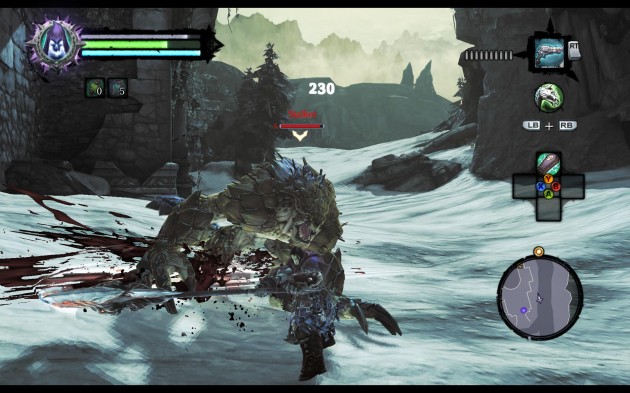
Eat it, Stalker
Death is worth it
 Despite the minor issues, this game is stellar. For most people, it’s worth buying at full price, and I don’t say that about many games at all. For many, waiting until it drops to the $20-$30 range will be fine, as it’s sure to go on Steam sale before the end of year. If you decide to wait, though, don’t feel bad when your friends who bought it now are having a blast and talking about what a great game it is. CoH2 beta key might be good too 68D87-XK9I8-0G4E7.
Despite the minor issues, this game is stellar. For most people, it’s worth buying at full price, and I don’t say that about many games at all. For many, waiting until it drops to the $20-$30 range will be fine, as it’s sure to go on Steam sale before the end of year. If you decide to wait, though, don’t feel bad when your friends who bought it now are having a blast and talking about what a great game it is. CoH2 beta key might be good too 68D87-XK9I8-0G4E7.
The story that may never be told about Darksiders II is that it is genre-bending in ways that haven’t been seen since Borderlands. Just as Borderlands billed itself as an FPS that turned out to be an awesome RPG, so too will Darksiders II be shown to be a deep and satisfying RPG with a non-publicized full fighting game in it, all wrapped in the guise of “just another fantasy brawler”.
For the first time in our history, I’m awarding a video game one of our Silver awards for product excellence. We normally reserve these rewards for hardware, but Darksiders II is just too good a game to not grant some kind of reward to. We don’t believe in arbitrary review scores here at Icrontic, but I do believe this game deserves recognition. It certainly broke boundaries for me and turned me on to a whole new genre of games that I never cared to explore before.
Darksiders II is available now for PC, Xbox 360, and PlayStation 3. This review was based on the PC version of the game. A Wii U version will be available when appropriate.




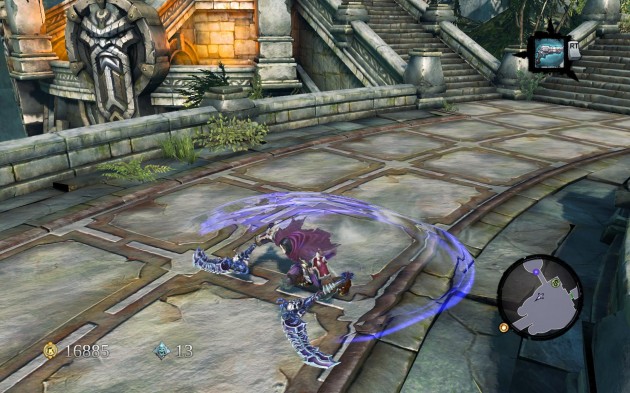

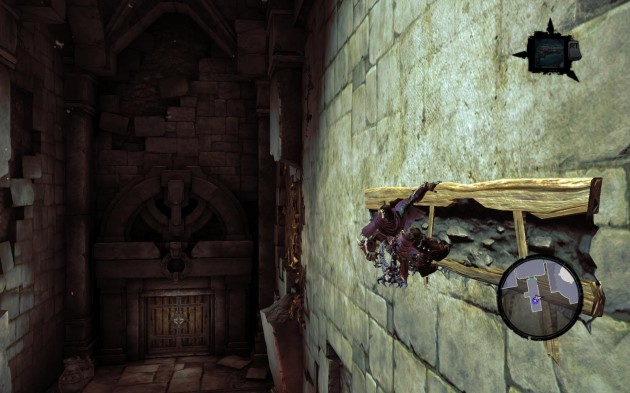
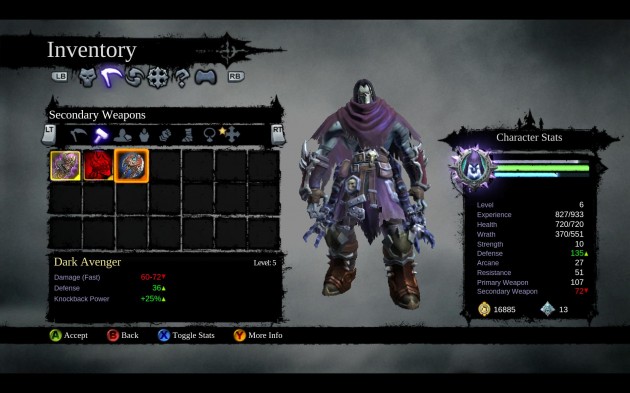












 Articles RSS
Articles RSS